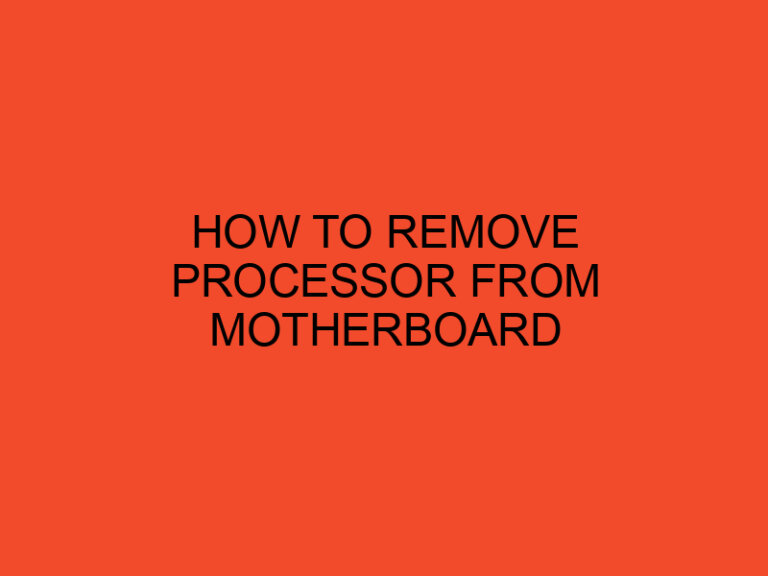Intel NUC kits are mini-PCs that pack a lot of power into a compact form factor. These machines come with powerful processors that make them suitable for various applications, including gaming, content creation, and general computing. However, some users may want to upgrade the processor of their NUC kit to improve performance or support new applications. In this article, we explore whether it is possible to change the CPU of Intel NUC kits and the steps involved in the process.
Table of Contents
Is it possible to change the CPU of Intel NUC kits?
Yes, it is possible to change the CPU of Intel NUC kits. However, the process involves technical skills, knowledge of computer hardware, and careful planning to avoid damaging the components or voiding the warranty. Moreover, the compatibility of the new CPU with the NUC kit depends on several factors, including the socket type, chipset, BIOS version, and power requirements.
What is an Intel NUC kit?
An Intel NUC kit is a small-form-factor computer designed by Intel Corporation. The term “NUC” stands for “Next Unit of Computing,” which refers to the compact size and high performance of these devices. NUC kits come in various configurations, with different processors, memory, storage, and connectivity options. Some NUC kits are designed for home entertainment, while others are suitable for business or industrial applications.
CPU architecture and compatibility
The CPU is the central processing unit of a computer that performs most of the calculations and instructions. Intel NUC kits use various CPU architectures, including Intel Core, Intel Pentium, and Intel Celeron processors. These CPUs are designed to fit into a specific socket type, which determines the physical and electrical compatibility with the motherboard.
To upgrade the CPU of an Intel NUC kit, you need to ensure that the new CPU is compatible with the socket type, chipset, and BIOS version of the NUC kit. Moreover, you need to check the power consumption and heat dissipation of the new CPU, as some models may require more power or generate more heat than the original CPU.
Reasons to upgrade the CPU
There are several reasons why you may want to upgrade the CPU of your Intel NUC kit, including:
- Improved performance: A faster or more powerful CPU can improve the speed and responsiveness of your NUC kit, especially for demanding tasks such as gaming, video editing, or virtualization.
- Future-proofing: Upgrading the CPU can extend the lifespan of your NUC kit and make it compatible with newer software or hardware.
- Cost-effective: Instead of buying a new NUC kit, upgrading the CPU can be a more affordable way to get better performance and features.
Considerations before upgrading the CPU
Before attempting to change the CPU of your Intel NUC kit, you should consider the following factors:
Warranty and support
Opening the NUC kit and changing the components may void the warranty or cause damage that is not covered by the warranty. Moreover, Intel may not provide technical support or firmware updates.
Power consumption and heat dissipation
The new CPU should not exceed the power consumption or heat dissipation limits of the NUC kit. Otherwise, it may cause instability, overheating, or damage to other components. You should check the technical specifications of the new CPU and compare them with the original CPU before making the upgrade.
BIOS compatibility and configuration
The BIOS (basic input/output system) of the NUC kit may require a specific version or configuration to support the new CPU. You should check the Intel website or consult the user manual of the NUC kit to ensure that the BIOS is up-to-date and compatible with the new CPU. Moreover, you may need to configure the BIOS settings to optimize the performance or compatibility of the new CPU.
Steps to change the CPU of Intel NUC kits
Assuming that you have checked the compatibility and considered the factors mentioned above, here are the general steps to change the CPU of your Intel NUC kit:
Gather necessary tools and components
You will need a screwdriver, thermal paste, and the new CPU that you want to install. Make sure that the CPU is properly packed and handled to avoid damage from static electricity or physical shocks.
Remove the NUC kit from its housing
Unplug the NUC kit from the power source and any peripherals such as keyboard, mouse, or monitor. Open the housing of the NUC kit by unscrewing the screws or clips that hold it together. Be careful not to damage any cables or connectors inside the housing.
Remove the existing CPU and heatsink
Locate the CPU socket and the heatsink that covers the CPU. Gently release the retention mechanism that secures the heatsink and lift it up. The CPU should be attached to the heatsink by thermal paste or a locking mechanism. If it is attached by thermal paste, you may need to use a plastic card or a similar tool to carefully separate the CPU from the heatsink. If it is attached by a locking mechanism, release it and remove the CPU from the socket.
Install the new CPU and heatsink
Align the new CPU with the socket and insert it carefully, making sure that it is properly seated and the retention mechanism is engaged. Apply a small amount of thermal paste on the top of the CPU, spreading it evenly with a spatula or your finger. Place the heatsink back on the CPU and secure it with the retention mechanism. Make sure that the heatsink is properly aligned and tightened, but not too tight that it may damage the CPU or socket.
Reassemble the NUC kit and test
Close the housing of the NUC kit and screw or clip it back together. Plug the NUC kit back into the power source and any peripherals. Turn on the NUC kit and check if it boots up properly. You may also want to check the temperature, performance, and stability of the NUC kit using software tools such as CPU-Z, HWMonitor, or Prime95.
Conclusion
Changing the CPU of an Intel NUC kit is possible, but it requires technical skills, knowledge, and careful planning. You should consider the compatibility, warranty, power consumption, heat dissipation, and BIOS configuration before attempting the upgrade. If you are not comfortable with the process or unsure about the risks, you may want to consult a professional or stick with the original CPU.
FAQs
- Can I upgrade the CPU of any Intel NUC kit?
No, the CPU upgrade depends on the socket type, chipset, BIOS version, and power requirements of the NUC kit. You should check the technical specifications and compatibility before making the upgrade.
- Will upgrading the CPU void the warranty of my Intel NUC kit?
It depends on the terms and conditions of the warranty. Some warranties may allow upgrades if they are performed by authorized or certified technicians, while others may not cover any damages caused by third-party modifications. You should check the warranty policy and contact the manufacturer or seller for more information.
- What are the benefits of upgrading the CPU of my Intel NUC kit?
Upgrading the CPU can improve the performance, speed, and multitasking capabilities of your NUC kit. It can also enable new features or technologies that are not supported by the original CPU. However, the actual benefits may vary depending on the specific models and applications.
- How can I know if my Intel NUC kit is compatible with a specific CPU?
You can check the technical specifications and compatibility lists provided by Intel or the CPU manufacturer. You can also consult online forums, reviews, or tutorials from other users who have performed similar upgrades.
- What should I do if the new CPU does not work or causes issues in my Intel NUC kit?
You should first check the compatibility, installation, and configuration of the CPU and the NUC kit. You may need to remove and reinstall the CPU or adjust the BIOS settings. If the issue persists, you may want to seek help from the manufacturer, the seller, or a professional technician who is experienced with Intel NUC kits and CPU upgrades.






